All About Mead: What is Mead? Is Mead Beer? Is Mead Wine? What are the Differences Between Beer vs Mead vs Wine?


Despite being one of the first alcoholic beverages ever produced by humans, mead is a relatively uncommon drink in the United States. That is, until recently, when mead has become increasingly popular as part of the expansion of the craft beer movement into other types of alcoholic beverages. Suddenly, small, local meaderies have begun to pop up around the country, and homebrewers have even gotten in on the action by fermenting their own mead.
But even with its increasing popularity, many people are still asking the same questions: What is mead? Is mead beer? Is mead wine? Don’t worry, we’ve got you covered. In this article, we’ll cover what is mead, what makes it distinct from beer and wine, and provide some recommendations on how to make your own mead.
What is Mead?
Mead is an alcoholic drink produced by fermenting a mixture of honey and water. In many meads, other ingredients, like spices, fruits, hops, and grains may be added to enhance the flavor. By definition, though, mead is made with honey and the primary source of fermentable sugar.
Mead ranges substantially in terms of flavor and alcohol content. Mead has a fruity flavor similar to a mixture of the flavors of white wine and hard apple cider. Mead can be produced to be either still or sparkling, and can range from completely dry to very sweet depending on the amount of sugar remaining post-fermentation. There are many types of mead with different flavors based on additions made during and after fermentation. The alcohol content of mead can range from quite low, about 3.5% alcohol by volume (ABV), to quite high, about 18% – 20%. The various types of meads are discussed later in this article.
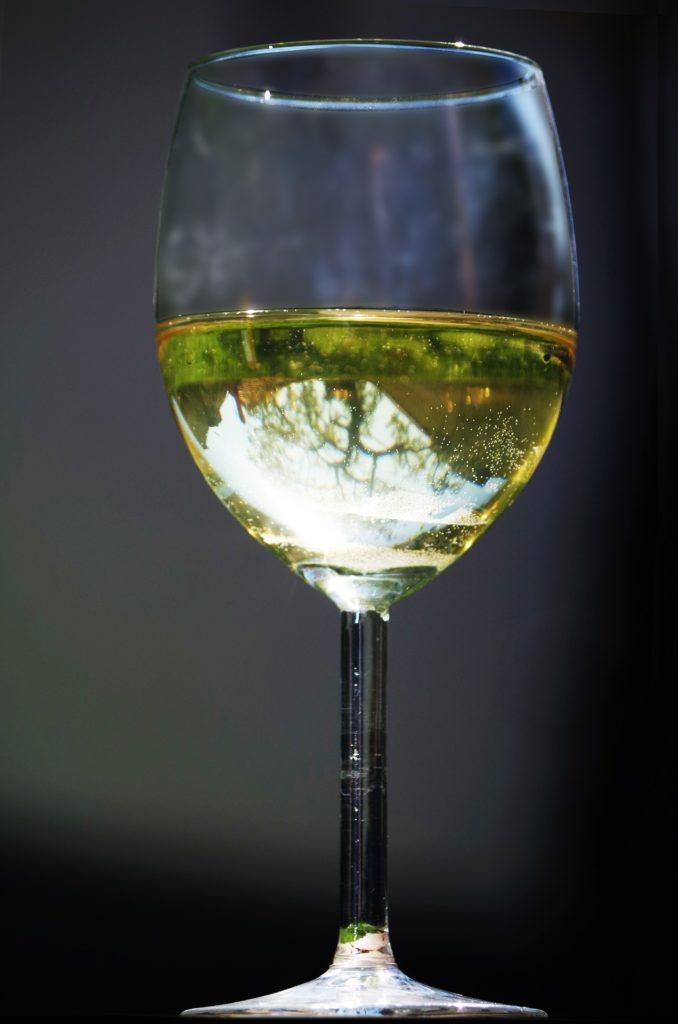

History of Mead
Mead is one of the oldest alcoholic beverages in the world with a history spanning 8,000 years.. There is evidence that people were consuming a fermented alcoholic beverage made from honey, fruit, and rice as far back as the 7th millennium BCE in China. Other mead-like beverages fermented from honey were commonly consumed by other ancient cultures, including the inhabitants of Scandinavia, Europe, and Greece.
The ancient Greeks, in particular, were known for their production of mead from honey. In medieval Ireland, mead became a popular drink once the practice of beekeeping began in around 400-500 CE. In Northern Europe, it was popular in places where grapes could not grow, and was produced and consumed by monks in monasteries.
Mead even has a place in Norse mythology, where it was believed to be the favorite beverage of the Norse gods, and was even referred to as the nectar of the Gods. Mead is even present in some of the oldest written Anglo-Saxon stories, including Beowulf. Most famously, mead was a favorite beverage of the Vikings, along with strong beer that was consumed during festive occasions.
Is Mead Beer?
Mead and beer are both fermented alcoholic beverages with ancient histories, but mead is not beer. Mead is more similar to wine than beer, and it is even sometimes called honey wine, however mead is not technically wine, either. In fact, mead is in its own category of fermented beverages. Mead, beer, and wine are fermented from different sources of sugar, and the production of beer follows a different process than the production of mead.
Beer is brewed from sugars extracted from barley, as well as other cereal grains like rye and wheat. At a high level, the beer brewing process involves:
- Malting grain, which is a process in which the grain is steeped in water, allowed to germinate, and then dried.
- Mashing the grain, which is a process in which the grain is milled to remove the outer layer and crack the grain, then put in hot water at specific temperatures to activate enzymes in the grain that extract the sugars into the water, which is now known as wort.
- The wort is then boiled, with hops added during specific parts of the boil to impart bitterness, aroma, and flavor.
- After the boil, the wort is cooled, transferred to a fermenter, and the yeast is added. The wort then ferments, which is the process by which the yeast consumes the sugar and produces alcohol. This process turns the wort into beer.
Unlike beer, mead is produced by fermenting sugar from bee honey. While small amounts of grain may be added to meads for flavor or body, the primary fermentable sugar must come from honey for the beverage to be considered mead.
Because mead is made from fermenting a mixture of honey and water, the process to produce it is a bit different. At a high level, the mead brewing process involves:
- Mixing honey and water together in a fermentation vessel.
- Adding mead yeast and yeast nutrient to the honey and water mixture. While there are commercially-available yeast nutrients, many mead makers use fruit, most commonly raisins.
- Seal the fermenter with an airlock and allow fermentation to complete, which usually takes at least two weeks to a month.
- After fermentation has completed, the mead is transferred to a secondary fermentation vessel, where it is stored for a few months of conditioning.
- Finally, the mead is bottled and is then ready for consumption.
As you can see, the mead making process is a bit easier than the beer brewing process, because it does not require malting, mashing, or boiling. Based on the differences in production and the differences in the source of primary fermentable sugar, mead is not beer, nor is it technically wine. Now that we’ve established that mead is not beer or wine, let’s discuss the primary differences between mead, beer, and wine.
Mead vs Beer vs Wine
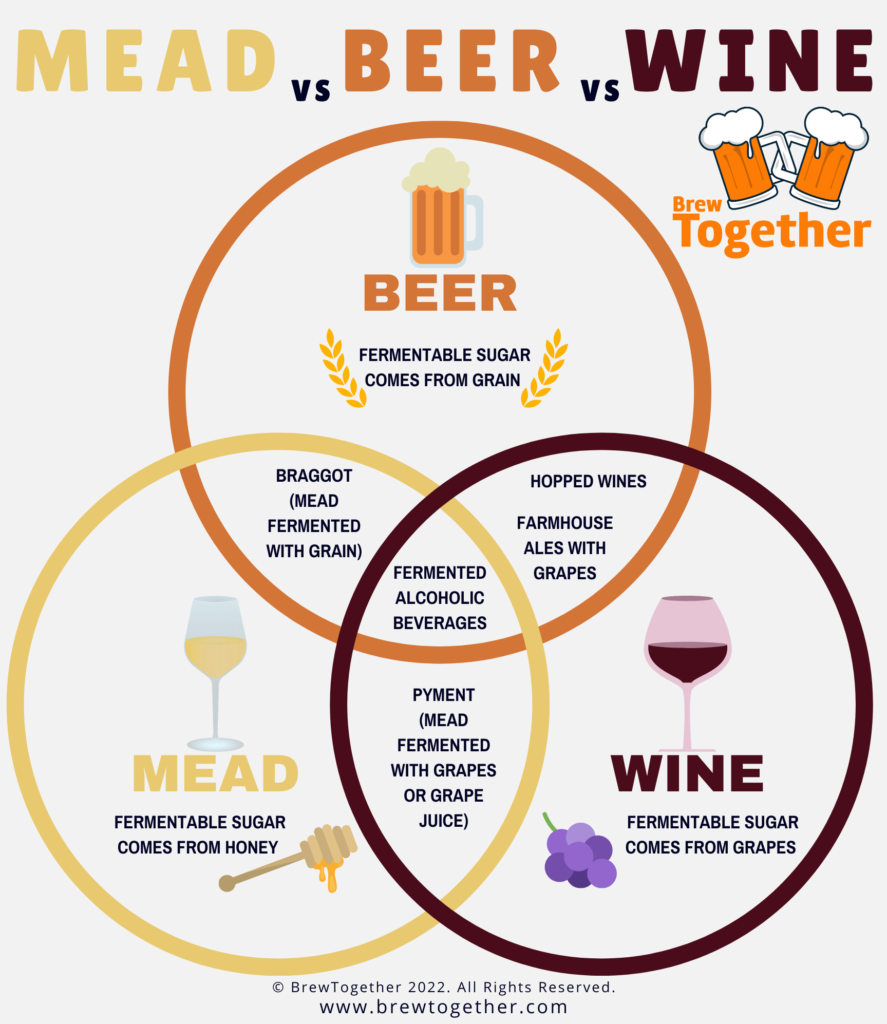

Sugar Source
One of the main differences between mead, beer, and wine is the basic ingredients used to make each, especially the source of the sugar that is fermented to create alcohol. Beer is made by fermenting sugars drawn from grains. Wine is made from fermenting grape juice. Mead is made from fermenting a mix of honey and water.
Flavor
Mead tastes more like wine than it does like beer. Mead has generally fruity flavors more similar to white grape wine, depending on the type of honey used and how much processing it has been through.
Alcohol by Volume (ABV)
Mead’s ABV range is generally a bit higher than beer’s. Mead can be as low as about 3% ABV and as high as 18-20%, where beer is usually between about 5-6% ABV on average. Wine tends to be about 14% – 18% ABV on average.
Types of Mead
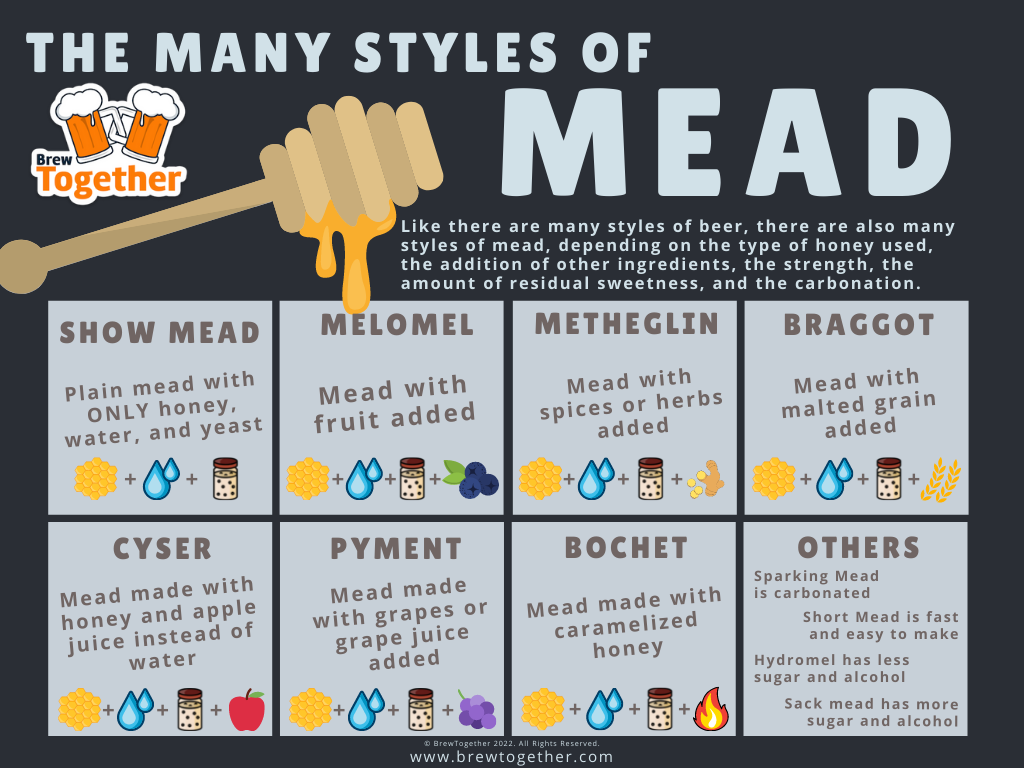

Like there are many styles of beer, there are also many different styles of mead, depending on the type of honey used, the addition of other ingredients, the strength, the amount of residual sweetness, the carbonation, and even the place where it is produced. The different types of mead represent a wide range of flavors and drinking experiences.
Show Mead
Show mead is the plainest form of mead, and consists only of honey, water, and yeast. No other ingredients, including fruit or spices, can be added to show mead.
Melomel
Melomel simply refers to mead that has fruit or fruit juices added. You will often see them referred to with the name of the primary fruit in the name, such as “Blueberry Melomel”. While fruit is present in these meads, it is there to impart flavor and color, and not as the primary fermentable sugar. Even in a melomel, sometimes called a fruit mead, the primary source of fermentable sugar is from the honey.
Metheglin
Metheglin is mead that is fermented with herbs or spices included in the honey and water. Common spices and herbs found in metheglin include cinnamon, cloves, lemon, mulling spices, ginger, pepper, rose petals, and even hops.
Braggot
Braggots are meads that also include sugars from malted grain. Think of a braggot as a mix of mead and beer. The exact amounts are argued a bit, and there is no exact rule for the amount of grain vs honey used.
Cyser
Cyser is mead made by mixing honey with apple juice rather than water, which makes the fermented product a mix between hard apple cider and mead. Because of the extra sugars from the apple juice, cyser is usually sweeter and more tart than normal mead.
Pyment
Pyment is mead made with grapes or grape juice, making it a combination of mead and wine. Generally, wine grapes like Chardonnay or Shiraz are used to make pyment mead.
Bochet
Bochet mead is made by caramelizing the honey used to make the mead prior to fermentation. Because the honey is caramelized, it imparts flavors of toffee and toasted marshmallow to the final product.
Other Categories of Mead
Sparking mead, unsurprisingly, is any style of mead that has been carbonated. Generally mead is carbonated through bottle conditioning, in which a small amount of sugar or honey is added to the mead before it is bottled so that the yeast in the bottle consumes the sugar to produce carbon dioxide.
Short mead is a simplified version of mead that is faster and easier to make. Generally, when mead is homebrewed (especially from kits), it is considered to be short mead.
Great mead is mead that is designed to be aged for a substantial period of time after it is bottled.
Hydromel is mead made with the lowest alcohol content by adding a smaller amount of honey to the water. Think of hydromels as essentially a session mead. Hydromels, or session meads, usually have between 3% and 7% ABV.
Sack mead is made with a lot of honey, which ensures that it will have a very high alcohol by volume (ABV). Sack meads have as much alcohol as the yeast can produce before dying, which is usually about 18%.
Is Mead Hard to Make? What Equipment Do I Need to Make Mead?
When compared to making beer, mead is quite easy to make and requires minimal equipment. Because there is no boiling required, all that is needed is a fermentation vessel with an airlock. If you already make your own beer and want to try something new, mead is a great choice.
If you’re not sure where to start with choosing a fermentation vessel, check out our guide to the pros and cons of glass vs plastic vs stainless steel fermenters. If you’re going all-in and buying a conical fermenter to make your mead, check out our guide to the best ones here.


If you’d prefer to buy everything you need all at once, there are some good equipment kits out there, including this 1-gallon mead making equipment kit, and this 5-gallon mead making equipment kit. These kits have everything you need to start making your own mead at home.
Quick and Easy Homebrew Mead Recipe Kits
Mead is easier to make than you might expect! If you’re completely new to fermenting or aren’t confident in your meadmaking abilities, you might find using a mead recipe kit is the easiest way to get started. Luckily, Adventures in Homebrewing carries a full line of mead making recipe kits for you to try, including:
- Sweet Traditional Mead
- Dry Traditional Mead
- Peach Mead
- Margarita Mead
- Blueberry Mead
- Apricot Mead
- Raspberry Mead
- Blackberry Mead
- Cherry Mead
- Orange Blossom Mead
If you’re feeling adventurous and want to make mead from scratch without a kit, head on over to the Mead Forum on the BrewTogether Forums to see recipes from the BrewTogether Community and ask advice from experienced mead makers! While you’re at it, you should join BrewTogether! It’s a completely free social network just for homebrewers, and we’d love to have you as a member!
Best Honey for Mead
There are over 300 distinct varieties of honey, and just about any type of honey can be used to make mead.The type of honey you choose for your mead, along with the yeast, will determine the aroma and flavor that you have in the finished mead. Honey can be light or dark, mild or strong, pasteurized or raw, and comes in tons of flavors based on the type of nectar the bees made it from. Different varieties of honey have different flavors, aromas, and textures.
You’ll encounter three main types of honey:
- Single origin honey is honey that comes from nectar mainly from a specific plant. A common example of single origin honey is clover honey.
- Multi-flower honey is honey that comes from nectar that bees have collected from different types of plants. A common example of multi-flower honey is wildflower honey.
- Local honey is honey made from nectar that is collected from a specific territory or geographical region. You’ll often see local honey produced by small, independent apiaries (places that practice beekeeping and produce honey).
One word of caution: make sure that the honey you’re buying is actually real pure honey. It’s shockingly common to find that products sold as “honey” are actually cut with plant-based sugars, including high-fructose corn syrup. Always make sure to get your honey from a reputable source, like Adventures in Homebrewing, who sells a variety of honeys that are perfect for making mead. Buying local honey from a trusted local beekeeper is also a great way to ensure you’re getting real honey.
Best Types of Honey for Mead
Generally, stronger and darker varieties of honey work best for mead, because they have enough color and flavor to survive the fermentation process. Light honeys, like alfalfa honey, do not make great mead as they don’t leave enough flavor or color to provide a complex flavor or attractive final product.
Wildflower Honey
Wildflower honey is diverse and complex because it is produced from the nectar of a variety of plants. Because of the diversity in wildflower honey, it can be a bit hit and miss, and it is almost impossible to replicate a batch of mead perfectly using wildflower honey. Still, it is a lot of fun to experiment with, and it’s a great way to see how different batches of honey can create drastically different finished meads. Wildflower honey can be used to make any type of mead.
Orange Blossom Honey
Orange blossom honey is made from bees who consume nectar from orange trees, which imparts a light citrus flavor to the honey. Orange blossom honey is light amber in color, which results in a beautiful light gold mead. This honey works great in several types of mead, including show mead, metheglin, and melomel. Overall, orange blossom honey is one of the most popular types of honey used in mead making, and it’s also a great choice for new mead makers. It produces a very well-balanced mead whether it’s sweet or dry.
Buckwheat Honey
Buckwheat honey is a particularly strong, dark honey that can be used in making mead. It has a strong earthy flavor that is a bit similar to maple syrup. It is thick and has a dark molasses-like color. While some mead makers ferment meads with 100% buckwheat honey, generally it is considered to be too strong and is blended with lighter honeys when making mead. Buckwheat honey, along with other dark, strong honey, is best used for metheglin rather than melomels or show meads because the strong character of the honey interacts well with herbs and spices.
Clover Honey
A lot of great meads are made with good clover honey. It is light and mild, but has a strong enough flavor to create a complex finished product. Clover honey is usually the cheapest type of honey available, but it can still be used for making great mead. Clover honey is a single origin honey that is easily mass produced, but beware of additives like high-fructose corn syrup. Clover honey can be purchased as bulk honey in stores like Costco, which reduces the cost (but also the quality) of mead. Still, many mead makers have made fantastic meads using cheap clover honey.
The Best Yeast for Mead
Just like for brewing beer, there are a ton of yeast options for mead making, and many people have their favorite yeast. Yeast and water are often taken for granted when brewing beer, and people don’t always realize how much of an impact choosing the right type of yeast can make on the final product. The same is true for choosing yeast for mead.
While raw honey will often contain a small amount of a number of wild yeasts, it may not be enough to initiate fermentation, and it likely will not provide the flavors and ABV desired. For that reason, the best meads are made with commercial yeast.
Factors to Consider When Choosing a Yeast for Mead
When choosing the right yeast for mead, you need to consider a few important factors:
The temperature at which you are planning to ferment your mead
Different yeast strains have different ideal temperature ranges, which is the temperature at which it efficiently ferments sugar without imparting any undesirable characteristics. Make sure you consider the temperature of the place where you are planning on fermenting the mead and ensure that you choose a yeast that is comfortable at that temperature.
The desired alcohol content of the finished mead
Different yeast strains can survive in different levels of alcohol before dying out and stopping the fermentation process. Some yeast strains cannot survive in solutions with more than about 5 percent ABV, while others can survive in up to 18% – 20% ABV. Choosing a strain with too little alcohol tolerance will cause it to die off before it finishes fermenting the sugar, leaving you with a lower-alcohol sweet mead. Choosing a strain with too high of an alcohol tolerance will cause it to ferment all of the sugar in the mead, leaving you with a higher-alcohol, completely dry mead. Either of these situations may be desirable or undesirable based on the type of mead you’re trying to make, so ensure that you have considered it when choosing a yeast strain.
The flavor notes you hope to maintain or impart on the finished mead
Many yeast strains are known to impart certain flavors in beer, wine, cider, and mead. Some yeast strains are more effective at maintaining flavors of the pre-fermented beverage, while others are known to strip pre-fermentation flavors from a beverage completely. When choosing a yeast, consider the flavor profile reported by the producer and others who have used it to make sure that you have the flavors you want in the finished product, and avoid flavors that you do not.
Whether it is liquid or dried yeast
Commercial yeasts are available in both dry and liquid forms. Most liquid yeasts require refrigeration, which can make it risky to purchase them online during the summer months. It’s quite common to hear of homebrewers purchasing liquid yeast in July only to find out it has spoiled by the time it arrives. Until relatively recently, dry yeast had a reputation for being inferior to liquid yeasts, but that has changed a lot over the last several years, as dry yeasts have drastically improved in quality and selection. Some dry yeasts require rehydration prior to pitching, but others can just be sprinkled right into the wort or must. When choosing a yeast, consider the availability of the yeast, and whether it requires refrigeration.
The Best Mead Yeasts
While most saccharomyces cerevisiae yeast, including ale yeasts and wine yeasts, can convert the fermentable sugars in honey, there are some mead-specific yeasts that impart better character and are more aligned to the ABV ranges of mead than beer yeast is.
Here are some different yeasts we recommend for making mead. For each, we provide the ideal fermentation temperature range, the alcohol tolerance, the flavor profile, and some recommendations for use.
Lalvin D-47
Lalvin D-47 is probably the best overall option for new mead makers and even for many experienced mead makers. Lalvin D-47 is a dry wine yeast, making it inexpensive and easy to purchase online. With an alcohol tolerance of about 14%, it can handle any low to medium-high alcohol mead. It has an preferred temperature range of 59°F – 68°F (15°C – 20°C), which means it can ferment in many homes without the need for temperature control during fermentation. Perhaps most importantly, Lalvin D-47 is known to accentuate the flavors of honey in the finished mead rather than fermenting them away. It also leaves a nice body and mouthfeel, which prevents the finished mead from feeling thin. It ferments well in mead without the need for additional nutrients, with a strong flocculation and firm sediment. Basically, if you’re making just about any type of mead, especially semi-sweet meads under 12% – 14% ABV, Lalvin D-47 is a great choice.
Lalvin K1-V1116
Lalvin K1-V1116 (Montpellier Wine Yeast) is a dry wine yeast with a very high alcohol tolerance. It can bring a mead all the way up to about 18% ABV, making it a great choice for high-alcohol meads. It also has a large ideal temperature range, and performs great from 59°F – 86°F (15°C – 30°C). Lalvin K1-V1116 is known for imparting floral and fruity aromas and flavors in wine, making it a particularly good yeast for making melomels. If you’re looking to add floral or fruity character to your mead, for best results, ferment it at the lower end of the temperature range (around 60°F/16°C) to accentuate the floral esters. It doesn’t leave as much body as D-47 does, but it’s still a great choice for higher-ABV meads, or melomels.
Mangrove Jack M05
Mangrove Jack’s M05 is a dry wine yeast with a very high alcohol tolerance. It can bring a mead all the way up to over18% ABV, making it another great choice for meads with a higher alcohol content. It also has a large ideal temperature range, and performs great from 59°F – 86°F (15°C – 30°C). M05 promotes fresh floral aromas in mead, especially when fermented at the lower end of it’s ideal temperature range. Finished meads using this yeast will finish dry but will maintain a relatively full body and mouthfeel with a nice floral character. It’s a great choice for making a complex dry mead.
Wyeast 4184
Wyeast 4184 is a direct-pitch liquid yeast pack designed specifically to produce sweeter mead without needing to stabilize and backsweeten. It has an alcohol tolerance of only about 11% ABV, which is designed to leave about 2% – 3% residual sugar in an average mead. It has an ideal temperature range of 65°F – 75°F (18°C – 24°C), making it a perfect yeast for fermenting at room temperature throughout most of the year. It leaves a rich, fruity flavor profile, making it great for both sweet show meads and melomels. Unless you’re looking to make a dry mead or one with a high ABV, Wyeast 4184 is a great choice.
Wyeast 4632
If you liked the sound of Wyeast 4184 but want to create a dry mead or one with a higher ABV, check out Wyeast 4632. This liquid yeast is designed specifically to produce dry meads, with an alcohol tolerance of up to 18% ABV. It has a temperature range of 55°F – 75°F (13°C – 23°C) and produces very little sulfur, making it a very clean-fermenting yeast. It has been used in several award-winning meads, and comes highly recommended for dry meads.
White Labs WLP720 Sweet Mead Yeast
White Labs has isolated their own strain of yeast that is ideal for sweet meads or ciders (or cysers!). With an alcohol tolerance of up to 15% ABV, it can handle fairly strong meads while still leaving a bit of residual sweetness and fruit character. It has a bit more picky ideal temperature range, and works best between 70°F – 75°F (21°C – 23°C). We’re big fans of While Labs Yeast, and this is a great yeast for making mead.
Lalvin EC-1118
If you’re looking for a yeast that can ferment any sugar, anywhere, anytime, and at any temperature, look no further than Lalvin EC-1118. This is the yeast we use in our homebrewed hard lemonade AND our homebrewed hard seltzer, and we use it because it can ferment even in harsh conditions. EC-1118 can ferment anywhere from 45°F – 95°F (7°C – 35°C), which means you can basically ferment your mead anywhere with this yeast. A word of warning, though: this yeast will ferment just about anything completely dry, similar to champagne yeast. Don’t expect to have any sweetness or much body left after fermentation. This is a great choice for high ABV meads because it will ferment happily up to about 18% ABV, but unless you stabilize and backsweeten, be ready for a very dry mead. This mead is also a great choice for those who are fermenting mead at warmer temperatures.
Cheers!
We believe that craft beer and homebrewing is all about trying different things, so we recommend grabbing a glass of mead once in a while. Make sure you try a few different types, too. There’s a delicious mead out there for just about anyone’s taste. Just because you don’t love an 18% ABV dry mead definitely doesn’t mean you won’t love a 9% sweet melomel. Each time you drink good mead, you’re connecting back to a long history, and enjoying the ancient beverage that our ancestors would have called the drink of the gods. Cheers!
Thanks for Reading!
Still have questions about mead or anything else beer and brewing related? Leave a comment below or post in the forums! The BrewTogether Community is made up of an awesome group of homebrewers around the world that are always supportive and happy to help answer your questions!
Thank you for reading! If you like this article, please share it with your friends using the social media share buttons below! We need your help getting the word out about BrewTogether!
If you’re not a member of BrewTogether, we’d love for you to join! BrewTogether is completely free, and signing up is easy! Click here to join! We’d love to have you as a member of the BrewTogether Community!
Now using BrewTogether is easier than ever! Download the FREE BrewTogether Mobile App – available on both the Apple App Store and the Google Play Store! The BrewTogether App is completely free and drastically improves the experience of using BrewTogether on a mobile device.
Affiliate Disclosure: BrewTogether is a participant in the Amazon Services LLC Associates Program, an affiliate advertising program designed to provide a means for us to earn fees by linking to Amazon.com and affiliated sites. BrewTogether is also a participant in an affiliate program with MoreBeer, our favorite online homebrewing equipment/ingredients retailer. Some of the links in this article are affiliate links, which means that if you choose to make a purchase after clicking the link, I will earn a small commission at no additional cost to you. Please feel free to reach out with questions. Thank you for your support!



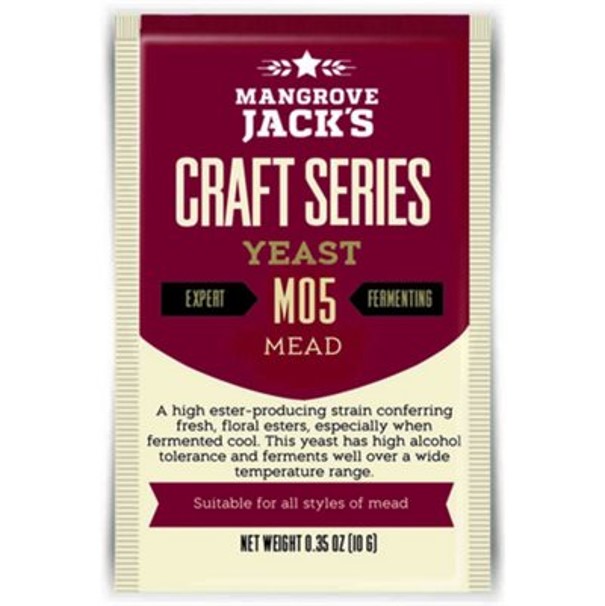
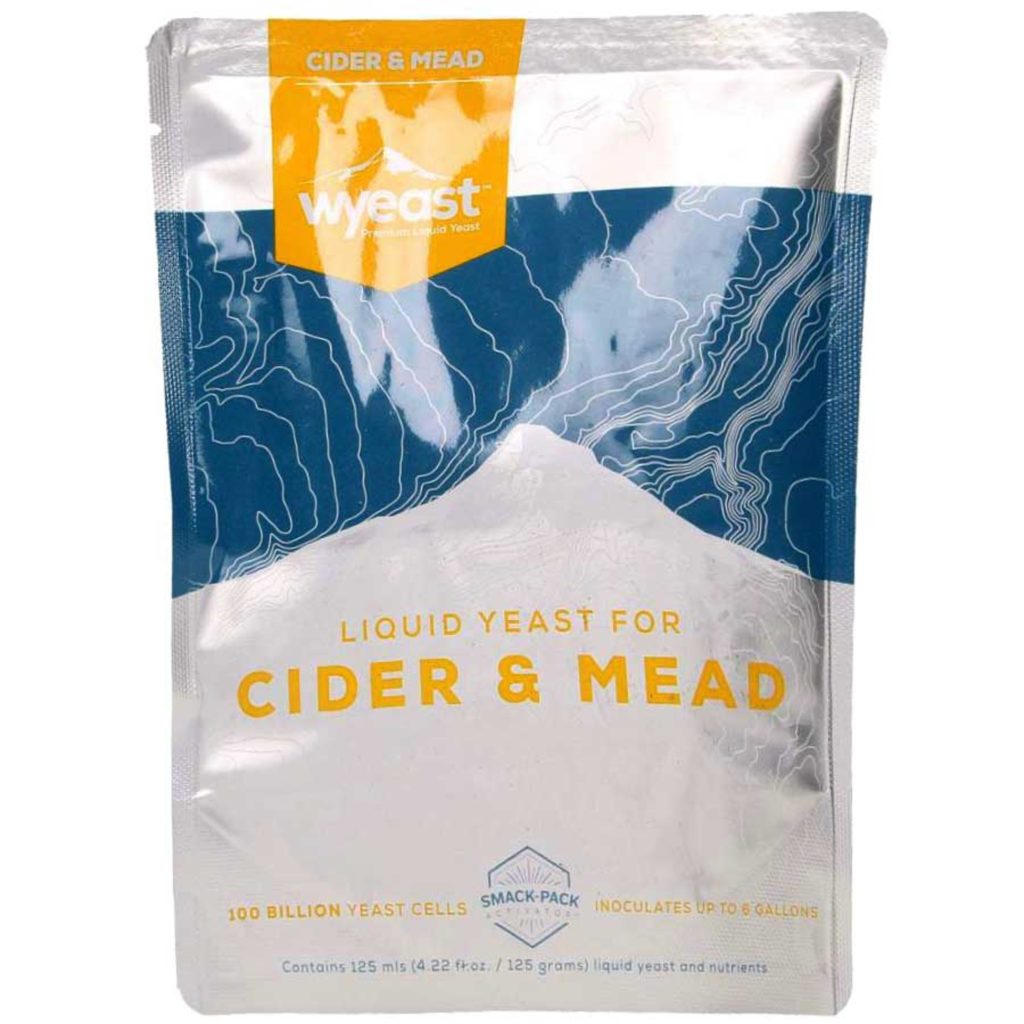
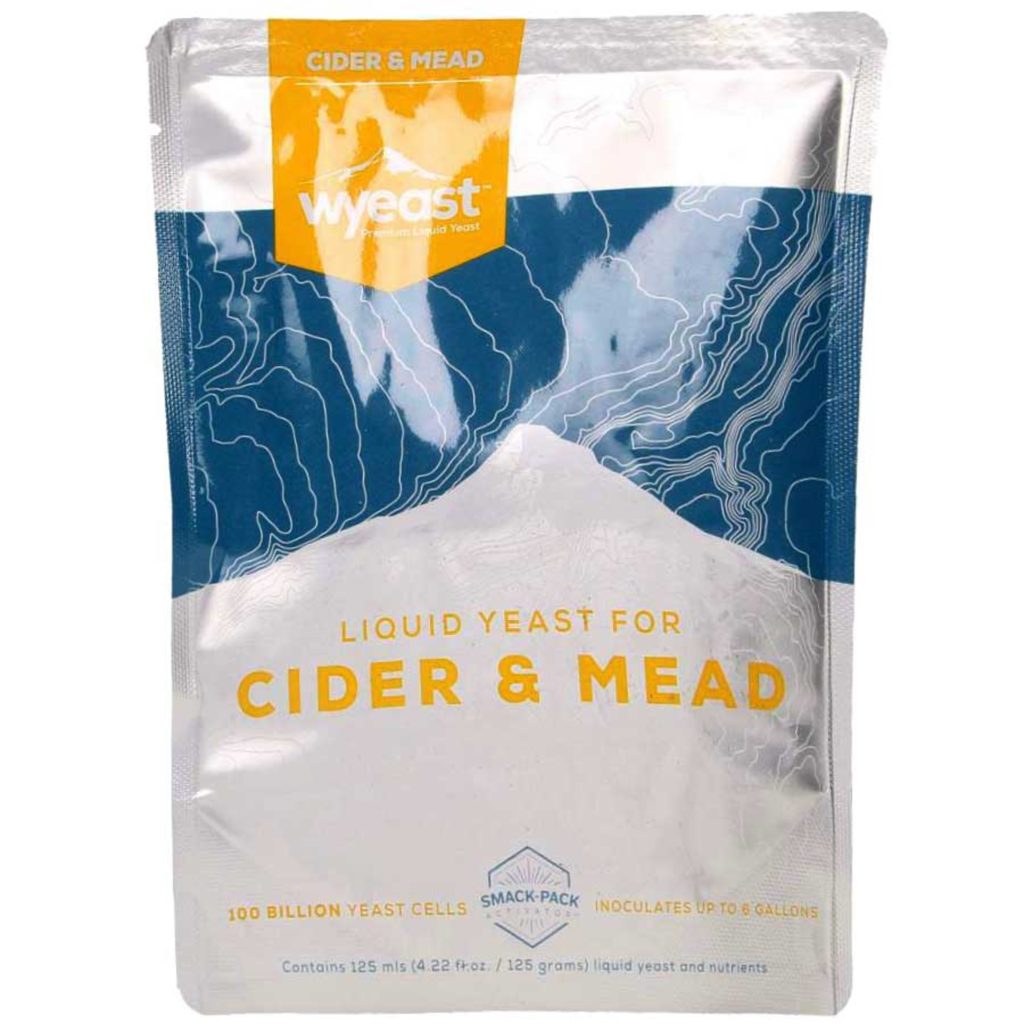







Responses